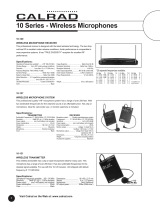
10
FCC Registration
FCC Registration
Your new JK Audio product has been registered with the Federal
Communications Commission (FCC). This product complies with the standards in
Part 68 of the FCC rules.
1. Connection and use with the nationwide telephone network
The FCC requires that you connect this telephone equipment to the national
telephone network through a USOC RJ-11C modular telephone jack. This
equipment may not be used with Party Line Service or Coin Telephone Lines.
This equipment is hearing aid compatible.
2. Information for the telephone company
Upon request from your local telephone company, you are required to provide the
following information:
A. The “line” to which you will connect the telephone equipment (that is, your
telephone number), and
B. The telephone equipment’s FCC registration number.This can be found on
the bottom of your telephone equipment, and,
C. The ringer equivalence number (REN) for this equipment. The REN is
used to determine the quantity of devices which will be connected to the
telephone line. Excessive RENs on the telephone line may result in the
devices not ringing in response to an incoming call. In most, but not all
areas, the sum of the RENs should not exceed 5.0. To be certain of the
number of devices that may beconnected to the line, as determined by the
total RENs, contact the local telephone company.
3. Repair Instructions
If it is determined that your telephone equipment is malfunctioning, the FCC
requires that it not be used and that it be unplugged from the modular outlet until
the problem has been corrected. Repairs to this telephone equipment can only
be made by the manufacturer or its authorized agents or by others who may be
authorized by the FCC. For repair procedures, follow the instructions outlined
under the warranty section of the manual.
4. Rights of the telephone company
If telephone equipment is causing harm to the network, the telephone company
may temporarily discontinue your telephone service. If possible, they’ll notify you
before they interrupt service. If advanced notice isn’t practical, you’ll be notied
as soon as possible. You’ll be given the opportunity to correct the problem,
and you’ll be informed of your right to le a complaint with the FCC. Your
telephone company may make changes in its facilities, equipment, operations or
procedures that could affect the proper functioning of your JK Audio product. If
such changes are planned, you’ll be notied by your telephone company.



















